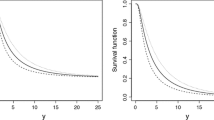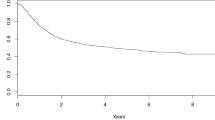Abstract
This paper propose a new cure rate survival model named the negative binomial–Lindley cure rate model by assuming that the number of competing causes of the event of interest follows the negative binomial distribution, and that the time to the event of interest has a Lindley distribution. The new model includes some cure rate models as special cases. Further, the cure rate regression model, which includes covariate information and parameters estimation for the proposed models are derived. In addition, this work also proposes the negative binomial–Lindley distribution as a new mixted lifetime distribution which is derived from the new cure rate survival model. Random variable generation and parameter estimation of the negative binomial–Lindley distribution are obtained. We illustrate the usefulness of the proposed cure rate survival model with covariate information for analysis of a real medical dataset.




Similar content being viewed by others
REFERENCES
F. J. Anscombe, ‘‘Estimating a mixed-exponential response law,’’ J. Am. Stat. Assoc. 56, 493–502 (1961).
R. G. Broadhurst and R. A. Maller, ‘‘Estimating the numbers of prison terms in criminal careers from one-step probabilities of recidivism,’’ J. Quant. Criminol. Meth. 7, 275–290 (1991).
V. T. Farewell, ‘‘A model for a binary variable with time-censored observations,’’ Biometrika 64, 43–46 (1977).
A. I. Goldman, ‘‘Survivorship analysis when cure is a possibility: A Monte Carlo study,’’ Stat. Med. 3, 153–163 (1984).
W. Q. Meeker and L. A. Escobar, Statistical Methods for Reliability Data (Wiley, New York, 1998).
J. W. Boag, ‘‘Maximum likelihood estimates of the proportion of patients cured by cancer therapy,’’ J. R. Stat. Soc. B: Stat. Meth. 11, 15–53 (1949).
J. Berkson and R. P. Gage, ‘‘Survival curve for cancer patients following treatment,’’ J. Am. Stat. Assoc. 47, 501–515 (1952).
J. G. Ibrahim, M. H. Chen, and D. Sinha, ‘‘Bayesian semiparametric models for survival data with a cure fraction,’’ Biometrika 57, 383–388 (2001).
A. D. Tsodikov, J. G. Ibrahim, and A. Y. Yakovlev, ‘‘Estimating cure rates from survival data: An alternative to two-component mixture models,’’ J. Am. Stat. Assoc. 98, 1063–1078 (2003).
F. Cooner, S. Banerjee, B. P. Carlin, and D. Sinha, ‘‘Flexible cure rate modeling under latent activation schemes,’’ J. Am. Stat. Assoc. 102, 560–572 (2007).
J. Rodrigues, V. G. Cancho, M. de Castro, and F. Louzada-Neto, ‘‘On the unification of long-term survival models,’’ Stat. Probab. Lett. 79, 753–759 (2009).
M. H. Chen, J. G. Ibrahim, and D. Sinha, ‘‘A new Bayesian model for survival data with a surviving fraction,’’ J. Am. Stat. Assoc. 94, 909–919 (1999).
W. Feller, An Introduction to Probability Theory and its Applications (Wiley India, New Delhi, 1968).
M. de Castro, V. G. Cancho, and J. Rodrigues, ‘‘A Bayesian long-term survival model parametrized in the cured fraction,’’ Biometrical J. 51, 443–455 (2009).
V. G. Cancho, E. M. Ortega, and H. Bolfarine, ‘‘The log-exponentiated Weibull regression models with cure rate: Local influence and residual analysis,’’ J. Data Sci. 7, 433–458 (2009).
H. Gomez, O. Pacheco, and H. Bolfarine, ‘‘An extension of the generalized Birnbaum–Saunders distribution,’’ Stat. Probab. Lett. 79, 334–338 (2009).
M. de Castro, V. G. Cancho, and J. Rodrigues, ‘‘A note on a unified approach for cure rate models,’’ Brazil. J. Probab. Stat. 24, 100–103 (2010).
V. G. Cancho, J. Rodrigues, and M. de Castro, ‘‘A flexible model for survival data with a cure rate: A Bayesian approach,’’ J. Appl. Stat. 38, 57–70 (2011).
V. G. Cancho, F. Louzada, and G. D. C. Barriga, ‘‘The Geometric Birnbaum–Saunders regression model with cure rate,’’ J. Stat. Plann. Infer. 142, 993–1000 (2012).
D. I. Gallardo, Y. M. Gomez, and M. de Castro, ‘‘A flexible cure rate model based on the polylogarithm distribution,’’ J. Stat. Comput. Simul. 88, 1–13 (2018).
M. de Castro and Y. M. Gomez, ‘‘A Bayesian cure rate model based on the power piecewise exponential distribution,’’ Meth. Comput. Appl. Probab. 22, 677–692 (2020).
D. V. Lindley, ‘‘Fiducial distributions and Bayes theorem,’’ J. Roy. Stat. Soc. B: Stat. Meth. 20, 102–107 (1958).
M. E. Ghitany, B. Atieh, and S. Nadarajah, ‘‘Lindley distribution and its Applications,’’ Math. Comput. Simul. 78, 493–5006 (2008).
S. Nadarajah, H. S. Bakouch, and R. Tahmasbi, ‘‘A generalized Lindley distribution,’’ Sankhya B: Indian J. Stat. 73, 331–359 (2011).
M. E. Ghitany, D. K. Al-Mutairi, N. Balakrishnan, and L. J. Al-Enezi, ‘‘Power Lindley distribution and associated inference,’’ Comput. Stat. Data Anal. 64, 20–33 (2013).
R. Shanker and A. Mishra, ‘‘A quasi Lindley distribution,’’ Afr. J. Math. Comput. Sci. Res. 6, 64–71 (2013).
F. Merovci and V. K. Sharma, ‘‘The Beta-Lindley distribution: Properties and applications,’’ J. Appl. Math. 2014, 1–10 (2014).
P. Jodra, ‘‘Computer generation of random variables with Lindley or Poisson–Lindley distribution via the Lambert W function,’’ Math. Comput. Simul. 81, 851–859 (2010).
P. K. Andersen and L. T. Skovgaard, Regression with Linear Predictors (Springer, New York, 2010).
T. Scheike, Timereg Package, R package Vers. 1.1-0, R package Vers. 1.1-6 (2009).
Author information
Authors and Affiliations
Corresponding authors
Additional information
(Submitted by A. I. Volodin)
Rights and permissions
About this article
Cite this article
Sirithip, W., Chookait, P. Negative Binomial–Lindley Cure Rate Model. Lobachevskii J Math 42, 3230–3240 (2021). https://doi.org/10.1134/S199508022201019X
Received:
Revised:
Accepted:
Published:
Issue Date:
DOI: https://doi.org/10.1134/S199508022201019X




